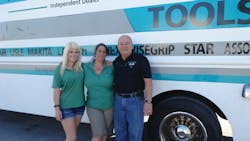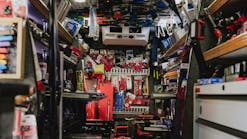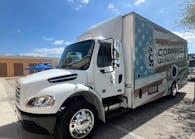Independent’s triple threat: multiple routes, retail store and repair service
Bob Petrilli has a seasoned eye for selling tools, having spent more than 40 years in a variety of roles: flag distributor, flag district manager, independent distributor, retail store owner and multi-route distributor. But as experienced as he is, he never stops learning. That’s because customers have different needs and a distributor has to be able to meet those various needs to win the business.
One thing Petrilli learned years ago is the need to make it as easy as possible for customers to get the tools they need when they want them. Hence, he operates three trucks and a retail store. By operating three trucks and having a retail presence that includes a tool repair shop, Petrilli makes it easy for customers to get tools when they need them. “We can get tools to customers faster than anybody else,” he boasts.
His company, National Tools, in Bradenton, Fla., serves an industrial area just north of Sarasota on Florida’s west coast.
With a dependable service and delivery system in place, Petrilli hopes to expand National Tools to new markets with additional trucks. He currently faces the challenge of finding the employees that will allow him to accomplish his goal.
Over the years, Petrilli has identified opportunities, worked hard, learned from his mistakes and kept up with changing customer needs. It all began 43 years ago in Detroit, Mich. when his cousin, a field rep for a national flag, asked him if he wanted to sell tools.
The 21-year-old Petrilli had held a series of menial task jobs and knew nothing about tools. But after riding on a tool truck, he felt it was something he could do. “I was a good talker,” he recalls. “And I was money motivated.”
He needed $25,000 to buy a truck and starting inventory. To help him, his father took a second mortgage on his house and lent him the money. “If I failed, he lost his house,” Petrilli recalls.
A natural salesman
Petrilli learned he was a natural salesman. “I had a blast,” he says. “I really enjoy selling tools.” His cousin, his field sales rep, helped him with product knowledge and inventory management. “Usually the best salesman is not a good businessman. Usually a good businessman is not the best salesperson,” he notes.
He was surprised by the amount of tools automotive technicians buy. He also had no idea how much time operating a tool truck requires. So in his first year, he discovered the opportunity and the responsibilities that came with it.
Over time, one of the greatest rewards was hearing from a customer how well a tool works for him. “The customers are the ones that get you excited about tools.” He also liked watching his customers’ businesses grow.
Foundation with a flag
As a flag distributor, Petrilli leaned many of the basics that he follows to this day.
He keeps track of both his sales and collections every day.
He lets established customers borrow tools before making a buying decision.
He oftentimes replaces broken tools even if he didn’t sell them, providing the customer is committed to buying from him.
He keeps on the lookout for new stops. He usually gives a stop three months before removing it from his route.
He gives all new customers a pen, a screwdriver and a calendar. This helps instill trust with new customers.
“You can be the most honest guy in the world, but if the customers don’t trust you, you’ll never succeed in this business.”
A fast rise
In his second year in the business, Petrilli was a top producer for his flag organization. The company soon offered him a position as a field sales rep, which he accepted.
He excelled in field sales, and several years later, the company offered him a promotion to be a sales manager in Miami, Fla. He gladly accepted.
In 1986, he lost his job as the flagship company was downsizing local branches in favor of larger regional officers and reducing its management staff. He became a distributor once again, this time in Bradenton, Fla., a growing community. The territory includes 20 square miles in Manatee County.
In 1990 and 1991, he experienced a divorce, which resulted in a large financial drain, causing him to exit the tool business.
A friend who was an independent distributor suggested he try his hand as an independent distributor. Petrilli investigated the opportunity and realized that as an independent, he would have more freedom in his tool purchasing decisions. He liked the idea of buying from different companies. So in 1992, he became an independent. He had no trouble converting his customers to his new business one month after leaving the flag organization.
He repainted his truck, a 1991 20-foot Grumman, to promote some of his manufacturer brands on the side of the truck: Channellock, Omega, Mastercool, Hanson, KD Tools, GearWrench, Power Probe, Devilbiss, Mountain and OTC, and others.
He purchased an inventory management software system, MM1 from Classic Computers, that allows him to track his sales and collections daily, along with a printer which enables him to print customer work sheets which he carries to every stop and to print customer receipts.
The software system also supports a credit/debit card reader, which proved helpful as more and more customers chose to pay with cards. Close to half of Petrilli’s sales are now made with credit and debit cards, and the percentage continues to grow. While credit and debit sales are less profitable than cash sales, he is able to schedule credit and debit payments, which is convenient for both the customer and himself.
Benefits of being independent
“It turned out to be the best thing I ever did,” Petrilli says of becoming an independent. “When you’re an independent, you make the rules.”
“The customer response is phenomenal,” he notes. “We bring them the best (quality tools) for a whole lot less money.” But because many tools are priced lower than those he sold as a flag distributor, he has had to sell more tools to achieve the sales volume he had reached when selling for a flag.
Petrilli likes having the freedom to buy from different warehouse distributors. He works with Ace Tool Co., Integrated Supply Network and Medco. “When you’re an independent, you’re treated as a customer by all your suppliers,” he says. Ace and ISN are located close to him and make getting tools to customers fast and efficient.
Independence has challenges
Being an independent does not come without its drawbacks. The biggest drawback, he says, is not being able to offer customers as much purchasing credit. Petrilli’s payment terms extend as long as 10 weeks, which is longer than that of most of the flags. He asks customers for the first week’s payment as a downpayment. His average balance on tools sold to technicians is $450. For tools sold to shop managers, it can be as high as $4,000.
“My (unpaid) balances are higher than theirs (the flags),” Petrilli notes. “They (the flags) have the ability to ‘flip’ a guy into a finance plan.” This has made it especially hard for him to sell toolboxes.
When a customer wants a toolbox, Petrilli sometimes refers them to a competitor. He tells his customer: “Tell them (his competitor) you want to buy a toolbox. Then you and I will fill it.” This tactic has actually proved helpful to Petrilli, who claims he has customers for whom he has sold every tool except for the toolbox.
He makes it a point to spend time with shop owners since he has found capital equipment to be a good business. Shop owners are usually reliable payers and the sales are much higher. It’s not unusual for a shop owner to give him one third down for a piece of equipment costing more than $3,000. “I stay as close as possible to the owners as I can,” he says.
Capital equipment sales do take some research. Before offering a piece of capital equipment, Petrilli makes sure it’s a sale he will profit from. If a shop wants something that he doesn’t think he will make enough profit on, he refers the customer to someone else. “I’d rather tell a person I can’t get them something than be embarrassed what I have to charge them,” he says.
While some distributors stay away from capital equipment because they don’t want to install it or assume any liabilities for it, Petrilli says the equipment manufacturers usually cover these areas.
Help with receivables
Getting to know shop owners has also helped Petrilli keep his losses below 2 percent of gross sales. The shop owners give him good insight as to which technicians might be problem payers. “Once you’ve been around, customers will warn you if a guy is on thin ice.”
Petrilli does not badmouth his competitors. In fact, he thinks competition is a good thing since competitors often reinforce the demand for the tools he sells. When a competitor promotes a certain item, Petrilli notices he sells more of that item, providing he carries it. “You need the competition to keep the excitement alive,” he says.
Petrilli credits his wife, Caryl, with keeping him focused and says he could not have found a better partner in life. “She outworks me, is great in sales, better on computers and a much better bookkeeper. I couldn’t have come this far without Caryl’s help.” She was also his first and best employee driver starting in June 1999.
Recession strikes
In 2008, the Great Recession hit. In Florida, the automotive, tourism and construction industries all suffered, taking a toll on repair shop activity and on distributor tool sales. “All you can do is stick to your terms (with customers) and ride it out,” he says.
Petrilli reasoned that having a retail store would make it easier for customers to pick up tools when they needed them and save him the trouble of making deliveries while he was running his route. So in 2010, he opened a retail store located right off the main business strip in Bradenton.
The store, open five days a week, proved to be popular with customers. One customer told Professional Distributor he finds the store very convenient. He said he likes dealing with National Tool. “If they don’t have it on the truck, they’ll get it for you,” he said. “They’ll come out of their way to meet your needs.”
The store also brought in some walk-in traffic, which accounts for about a third of its sales. But at the same time, it required hiring an employee. As Petrilli expanded, finding reliable employees became his single greatest challenge.
Petrilli closed the store after one year because he couldn’t find a dependable employee. A year and a half later, he reopened it when his wife, Caryl, had to stop driving her truck because of an accident. Caryl then managed the store.
He has since found an employee to manage the store and Caryl has resumed driving her truck.
Onsite tool repair
The store has also allowed Petrilli to offer his customers a tool repair service. He rented out 800 square feet of space in the 2,100-square-foot store to a repair shop, called Anchor Tool & Repair, that handles some of his customers’ repairs. The shop specializes in fixing air tools, electric tools and some hydraulic tools.
Petrilli views repairs as a customer convenience more than a profit center. If a repair costs more than half the cost of a new tool, he usually gives the customer a choice between a getting it repaired and buying a new tool.
Economy recovers
In 2011, business began to improve along with the local economy. But rising sales brings its own challenges, Petrilli notes. All of a sudden he needed to stock more inventory and his collections had not increased to the point that he could easily cover all the inventory he wanted to buy. It took time for him to buy the inventory he needed to meet all of his customer requests.
Petrilli has continued to pay attention to the basic sales and management practices that have served him well over the years.
He mainly “totes and promotes” new items. “Toting and promoting gives you a chance to see what they want, even if it’s not what you bring in.”
He has found success getting shops to sponsor gift certificates for tools on his trucks. The shops find it a novel way to reward their employees. The gift certificates are good for $150 to $600 in tool purchases, and they cannot be used towards account balances. Petrilli signed up about 20 of his shops for this program this past winter.
“It’s a good way to make the sale. The boss doesn’t have to go shopping for the tech.”
The biggest sellers in recent years have been jump boxes, scan tools and cordless power tools. These have all been positive developments for distributors because these are all fairly high-ticket items.
“These little jump boxes have been a shot in the arm to that huge (jump starter) business.” Customers were surprised that a jump starter could be contained in such a small box. Ace Tool Co. was the first warehouse distributor to offer the Zeta jump box. Petrilli sold out of his entire first order of 60 units in 30 days.
Scan tools also represent a growing category. These tools, however, require more education than most tools. To educate customers, Petrilli has organized scan tool classes for his customers taught by his scan tool suppliers. Bosch OTC and Autel are his main scan tool manufacturers.
In the future, Petrilli thinks reflashing tools will become popular. Right now, there are a handful of shops that do most of the reprogramming in the area.
Customers are also asking more questions about tools for air conditioning equipment for hybrid vehicles and for the new R-1234yf refrigerant.
The business expands
With two trucks and a retail store in place, Petrilli looked to add more trucks.
His 22-year-old daughter, Leah Arslanian, became his second employee driver in 2011. Instead of providing her a 20-foot truck, Petrilli gave her a Ford van with ceiling and doors outfitted with pegboard threaded with bungie cord for displaying tools. Called the “Mobile Express,” the van visits about 23 stops a day and typically generates $7,000 in weekly sales.
The van doesn’t do as much business as the 20-foot truck, which typically does $3,000 more per week, but the operating costs are much less.
Petrilli has been pleasantly surprised by how well his daughter has done with the “Mobile Express.” Leah herself was uncertain at first if she would succeed. But thanks to her success, she canceled her earlier plans to become a beautician.
Petrilli thinks the “MobileExpress” is a good way to start a new driver.
Future growth plans
Last year was Petrilli’s best year ever; his sales exceeded $1 million.
He hopes to find more drivers to accomplish his goal of having several routes. Although 64 years old, he thinks he has several working years ahead of him. When he is ready to slow down, he believes his wife and daughter will be ready to take over.
Finding good employees isn’t the only challenge Petrilli is facing as he looks to add more routes. As a full time driver himself, he doesn’t have a lot of time to train new drivers.
In the meantime, he is grateful for his career in tool sales. “What better thing can you do?” he asks, noting that he can’t think of a more rewarding career.
Bob Petrilli’s Top 5 Tools
- Autel MaxiDAS 708 Diagnostic System
- Streamlight Stinger LED flashlight
- Makita 18V cordless drill
- GearWrench 16 pc ratcheting combo wrench set,
No. KD 9416 - Clore Automotive Solar Jump-N-Carry jump starter


